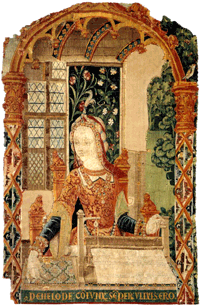Prof. Dr. Tristan Weddigen
An Iconology of the Textile
The Principal Investigator’s own contribution consists in a book-length publication which encompasses main aspects of the overall project, focusing mainly on tapestries. Some of the chapters have been presented as papers, some others have been tested in seminars and lecture courses. The contents of the book can be summarized as follows:
1. Historical and Methodological Introduction: the introduction shall critically analyze the scholarly discourse about the textile arts in the discipline of art history since Giorgio Vasari and discuss its major elements such as the theoretical dominance of disegno and painting, the different methodological approaches taken in research so far, and the social and gender issues of academic practice in relation to textile studies.
2. The Apocalypse of Angers: this chapter will analyze one of the most important tapestries of the middle ages as to explore the important aspects of a self-reflection of the textile medium, especially the ekphrastic and rhetorical structures of the Apocalypse tapestry in relation to the paragone Dante established between the visual arts and poetry in the Purgatory (the wall of images).
3. Raphael’s Acts of the Apostles for Pope Leo X: this chapter, for which a great deal of material has been collected over the past years, reveals the self-reflective visual discourse of the most famous tapestry set of the Renaissance, by analyzing such aspects as the allusion to the Tabernacle of Moses, to luxury criticism of Catholic reformers, the paragone etc.
4. Charles Le Brun’s Histoire du Roi for Louis XIV: this part of the book is based on material collected since 2009 and offers a new reading of one of the great sets of the 17th century, focusing on the role of the Gobelins as means of royal self-representation by the means of the arts.
5. Textile Abstraction at the Bauhaus: this chapter shall focus on the relationship between textile technology and abstraction, leading later to Greenbergs so-called carpet paradigm.
6. The Gender of the Textile Medium in Contemporary Art: the last part of the book shall explore the historical gender myths active in modern and contemporary textile arts and also their social impact onto academic research, thus closing the circle begun with the introduction to the book.
The Principal Investigator is currently publishing an article on woven Veronicas, preparing a book chapter of the Getty Research Institute on textile interior decoration of Roman palaces, and collecting material for a paper on gender issues in contemporary textile art (Louise Bourgeois et al.).
